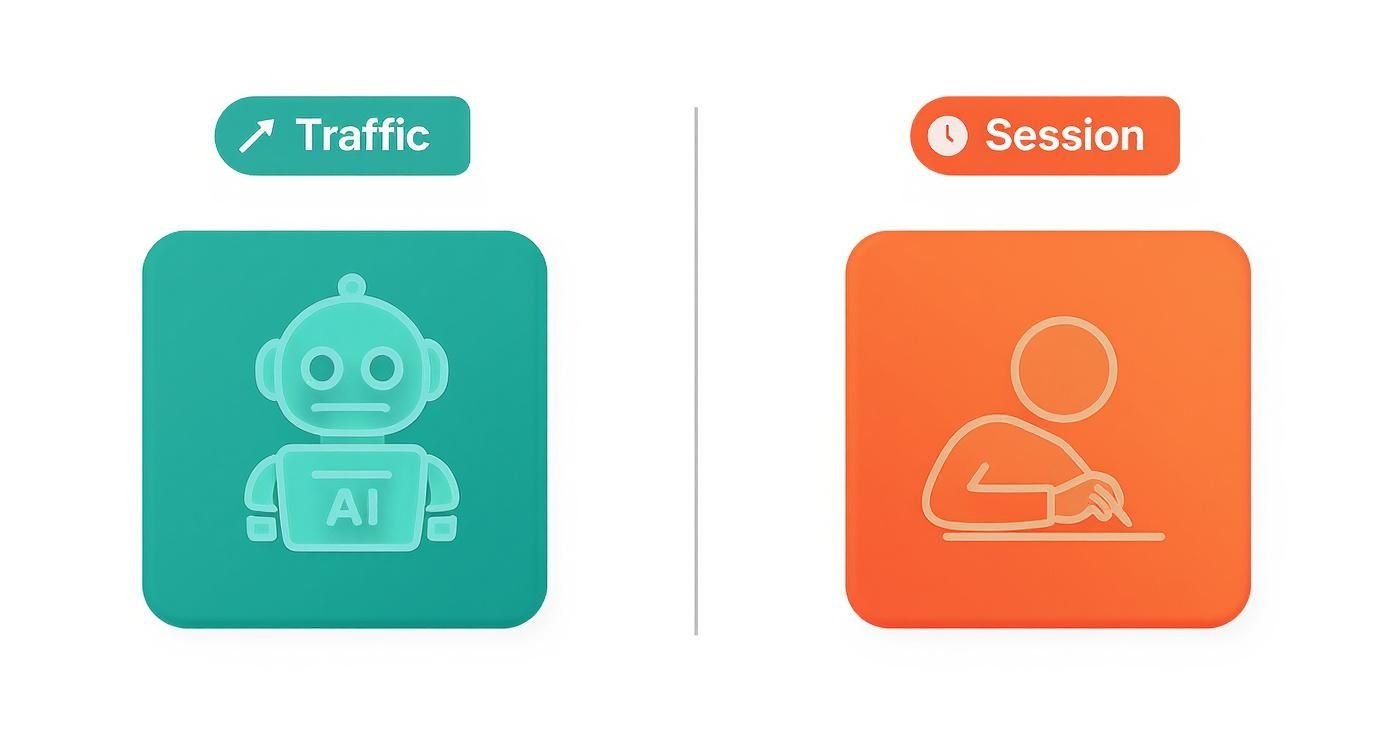How to Humanize AI Content and Connect With Readers

To truly humanize AI content, you need to add your personal voice, stories, and a genuine point of view. It’s all about changing that robotic, generic text into something that feels real and trustworthy to your readers. This isn't about tricking detectors; it’s about creating a real connection.
Why Human-Touched Content Still Connects Better
In a digital space flooded with machine-written articles, the value of a genuine human touch is growing quickly. Let's be honest, readers are getting pretty good at spotting the difference between a raw AI draft and a piece that's been thoughtfully worked on. That distinction is found in the small things that build trust and make content memorable. While exploring the latest generative AI tools is a great starting point, the real magic happens in the editing room.
Sure, AI is fantastic for banging out outlines and first drafts, but it often misses the core parts that make writing compelling.
- A Distinct Point of View: AI is a fact-reporting machine; it doesn't have personal beliefs or experiences. A human editor is vital for adding a personal perspective that makes the content stand out.
- Authentic Storytelling: Real stories and personal tales forge an emotional connection that purely factual content just can't match.
- Consistent Voice and Tone: Your brand’s personality comes alive through your specific word choices and style—something a machine can only imitate, not truly invent.
The Proof Is in the Performance
The numbers don't lie: readers not only prefer human-edited content, but they also connect with it on a much deeper level. One study found that while machine-written pages are multiplying online, human-written articles bring in 5.44 times more traffic. Even more telling, they hold reader attention for 41% longer. That’s a huge difference that directly affects your reach and authority.
The graphic below breaks down just how stark the performance difference is.
When you look at the numbers, it's obvious that longer sessions and higher traffic are the direct results of content that feels real and trustworthy.
To give you a clearer picture, let's compare the typical performance metrics side-by-side.
AI-Produced vs Human-Edited Content Performance
| Metric | Raw AI Content | Human-Edited Content |
|---|---|---|
| Average Time on Page | Low (under 1 minute) | High (2-4+ minutes) |
| Bounce Rate | High (often >70%) | Lower (typically 40-60%) |
| Organic Traffic | Minimal, struggles to rank | Much higher |
| Conversion Rate | Very low | Higher, builds trust |
| Reader Trust | Low, easily identifiable as generic | High, feels authentic |
The takeaway here is simple. While AI gives you a head start, the real gains in traffic, reader interest, and trust come after a human has put the final touches on the product.
To humanize AI content is to invest in your relationship with your audience. It shows that a real person cared enough to check the facts, share a genuine perspective, and create an experience worth reading. This is a very important step for anyone serious about building a loyal following. Learn more by reading our article on why humanizing AI content is essential for engagement.
Finding Your Personal and Consistent Voice
Your brand's voice is its personality. It's that distinct flavor that makes your content instantly recognizable, separating you from the generic noise. Think of it as the difference between a dry instruction manual and a conversation with a trusted friend.
An AI can't just invent this for you; it can only follow instructions. So, to truly humanize the AI content you're creating, you have to first get really certain on what makes your voice yours.
How do you want your audience to feel when they read your stuff? Informed, amused, inspired, challenged? Your answer is the compass that guides everything from your word choice to sentence structure. A brand that wants to be supportive might use phrases like "We've all been there," while a witty one might lean on playful comparisons and a touch of sarcasm.
From Abstract Idea to Actionable Prompts
Once you have a handle on the feel of your voice, the real trick is turning that into instructions an AI can actually understand and follow. Simply prompting "write in a friendly tone" is a recipe for bland, generic text. You've got to be way more specific.
I recommend creating a simple "Voice and Tone" document. This doesn't need to be some 20-page brand manifesto. A few key bullet points can make a night-and-day difference in the quality of your first copy.
- Go-To Phrases: Jot down 3-5 phrases that are quintessentially "you." For instance, a productivity blog might constantly circle back to "work smarter, not harder."
- Words to Avoid: We all have them—corporate buzzwords or stuffy terms that make us cringe. List them out. Maybe you'd rather die than use the word "utilize" when "use" works just fine.
- Sentence Style: Are you a fan of short, punchy sentences? Or do you prefer longer, more descriptive writing? Make a rule, like: "Keep sentences under 20 words and stick to active voice."
By giving your AI these specific guardrails, you’re not just asking for a particular tone; you're teaching it the building blocks of your personal style. This makes the editing work much smoother because the first copy is already closer to your ideal style.
Editing with Personality in Mind
Even with the world's best prompts, that raw AI output is going to need a human touch. This is where you come in to add the final layer of personality.
As you read through the text, look for chances to swap out bland, boring words for more expressive ones. The specific words you choose can completely change the vibe of a sentence. If you want to expand your toolbox here, exploring the different types of diction will give you a much richer vocabulary to pull from.
Don't just edit for grammar. Ask yourself, "Does this sound like something a real person in my industry would actually say?" If the answer is no, it’s time to rewrite.
This is where a tool like Word Spinner truly shines. Its leading rewriting functions can help you untangle clunky, AI-sounding sentences and rephrase them into something that flows naturally. It helps make sure your final piece not only reflects your voice and removes ai detection but is also 100% plagiarism-free.
Weaving in Stories and Personal Anecdotes
Facts and data are the skeleton of a strong article, but stories are what give it a heartbeat. While an AI can spit out statistics in seconds, it can’t share a personal failure, a surprising win, or a funny customer interaction. This is your secret weapon to humanize the AI content you're working with.
Adding short, relevant stories isn't about adding fluff—it's about building a bridge between your message and your reader. An anecdote can bring a complex idea to life in a way a dry explanation never could. For instance, instead of just saying a product saves time, you could share a quick story about a chaotic Monday morning that was salvaged because of it.
This isn’t just a gut feeling; the numbers back it up. Recent findings show that human-made content performs better than its AI counterpart by about 47% on key metrics like time on page and bounce rate. On top of that, 51% of email marketers say AI-supported campaigns perform best only when a human touch is added to the mix. The numbers are plain: readers prefer content with emotional weight.
Spotting Opportunities in an AI Draft
Think of your first AI-produced text as a goldmine for storytelling opportunities. As you edit, keep an eye out for any section that feels too abstract, generic, or bland. These are the perfect places to add a bit of humanity.
- When explaining a problem: Don't just state the issue. Start with a relatable scenario. "Picture this: you're staring at a blank screen…" is way more interesting than "The primary challenge is…"
- When presenting a solution: Don’t just tell—show. A quick case study or a customer quote can make the benefits feel real and trustworthy.
- When introducing a key takeaway: Frame it with a personal experience. Sharing a lesson you learned the hard way makes your advice stick.
This is a core principle of good writing. If you want to really nail this technique, check out our guide on how to show and not tell when writing.
The goal is to make your reader nod along and think, "I've been there." That moment of shared understanding is what separates forgettable content from something that truly connects and builds a loyal audience.
Structuring Your Stories for Impact
A story doesn't need to be a long-winded detour. In fact, the best anecdotes are often just a few sentences long. A simple structure helps keep them tight and effective:
- The Hook: Kick things off with a relatable situation.
- The Challenge: Briefly touch on the problem or conflict.
- The Resolution: Explain how it was solved and tie it back to your main point.
By weaving in these small narrative threads, you can change a robotic text into a piece that feels real, emotional, and—most importantly—human.
A Practical Editing Workflow for AI Drafts
Getting a text from an AI is just the beginning; the real magic happens in the edit. It’s a huge mistake to treat an AI text like a finished piece. Instead, think of it as a pile of high-quality raw materials waiting for a skilled craftsman—that's you—to turn it into something polished and genuinely human.
A structured work method is your best friend here. It turns what could be an overwhelming task into a series of clear, manageable steps, making it much easier to methodically humanize the AI content.
The Three-Pass Editing Method
One of the most effective ways to tackle an AI text is with the three-pass method. Each pass has a specific goal, which keeps you focused and makes sure you cover everything from the big-picture structure down to the tiny details.
-
The Structural Edit (The Big Picture): Your first read-through is all about flow and logic. Don't get bogged down in grammar or word choice. Ask yourself: Does the intro grab the reader? Do the arguments make sense? Is the conclusion satisfying? This is your chance to rearrange paragraphs, cut entire sections that don’t add value, and make sure the article delivers on its promise.
-
The Line Edit (The Voice and Clarity): Now, it's time to go line by line. This pass is where you hunt down robotic phrases, clunky sentences, and stuffy corporate jargon. I highly recommend reading tricky passages aloud—if you stumble over a sentence, it needs to be rewritten. This is also where you add your personal style, a personal story or two, and lock in a consistent tone.
-
The Polish (The Final Details): Lastly, do one final sweep for grammar, spelling, and punctuation errors. Think of it as the final quality check before you hit publish. This step makes sure all your hard work isn't spoiled by a few simple mistakes.
Putting the Workflow into Action
To really nail the editing work, it helps to remember what you're working with. Tools like AI social media post generator tools are fantastic for getting ideas and structure quickly, but they seriously lack nuance.
For example, during your line edit, you might notice the AI used the word "implement" three times in two paragraphs. It's your job to swap those out for more natural alternatives. This manual touch is essential, but it can be a real time-sink on longer articles. For a more efficient system, it's worth exploring a structured content creation workflow that blends AI drafting with human editing from the get-go.
Pro Tip: Never edit immediately after the AI spits out the text. Step away for a few hours, or even a full day. When you come back with fresh eyes, you'll be amazed at how easily you can spot the awkward phrasing and soulless sentences that need a human touch.
For those moments when a sentence just isn't cooperating, a specialized tool can be a great help. Using Word Spinner during your line-editing phase can be a massive time-saver. Its rewriting abilities are perfect for untangling robotic sentences and finding better, more natural-sounding alternatives. It helps you humanize content quickly while making sure the final version is 100% plagiarism-free and avoids detection.
Fact-Checking to Build Reader Trust
Let's be real: AI tools are fantastic for brainstorming and getting a first text down, but they are not reliable sources of truth. They can—and often do—pull outdated stats, mix up quotes, or even just make things up. This little quirk has a nickname in the industry: "hallucination."
If you want to build a loyal audience, it all comes down to trust. That trust is built brick by brick, every time a reader sees that a real human has put in the work to check every single claim. This is a non-negotiable step in the process.
Showing your readers you’ve done your homework adds a powerful layer of credibility that raw AI output just can't touch. It’s a clear signal that you value truth over speed, which is a rare and respected quality these days.
A Simple Vetting Process
Fact-checking doesn’t need to be some monumental task. All you really need is a straightforward, consistent method to keep your standards high and protect your reputation. Before you even think about hitting "publish," just run through this quick mental checklist.
- Question the Numbers: Always treat statistics with a healthy dose of skepticism. A quick search should take you right back to the original study or report. Can't find a primary source? It’s much safer to just cut the stat than to risk publishing bad information.
- Check the Quotes: AI is notorious for putting words in the wrong person's mouth or yanking a quote completely out of context. Make sure you confirm who actually said it and that the original meaning fits your point.
- Link to Authority: Back up your big claims by linking out to established, reputable sources. This not only proves you know what you're talking about but also gives your readers a path to learn more.
The current state of online content really hammers this point home. As of late 2024, AI-made articles started to outnumber those written by humans. But despite the sheer volume, this machine-written content often tanks in search results, which tells us something important: it lacks the quality and trustworthiness that both people and search engines are looking for. You can discover more insights on this trend here.
This gap between quantity and quality is your opportunity. By taking the time to fact-check, you’re not just fixing potential errors; you're building a brand that people can actually rely on.
This commitment to the truth is what makes your content feel genuinely human. It shows you care about your audience and are dedicated to giving them the best, most truthful information possible.
Polishing Your Work for a Human Connection
That last 10% of effort is where the magic really happens. These final touches are what separate a decent text from a truly great piece of content that connects with people. It’s all about presentation and polish.
How you format your content is just as important as the words themselves. Nobody wants to read a giant wall of text on a screen—it's just too intimidating. Break your writing into short, snappy paragraphs, ideally no more than two or three sentences each. Use visual cues like bullet points and bold text to guide the reader’s eye to the most important bits.
The First Impression: Your Headline and Intro
Your headline and introduction are your only shot to hook a reader. An AI might produce a technically correct title, but it almost always misses the spark that makes someone want to click.
Think about what makes you click on an article. It’s usually a title that piques your curiosity, promises a real solution, or feels like it was written for you. So instead of a generic title like "Benefits of X," try something more personal and interesting, like "How X Completely Changed My Workflow."
The whole point is to make your content feel approachable. Good formatting tells the reader you respect their time, while a strong intro assures them they’re in the right place. These small details build trust right from the start.
Getting every sentence to sound perfectly natural during this last mile of editing can be surprisingly tough. When you need to be absolutely certain that every part of your text reads like a human wrote it and has zero robotic phrasing, a dedicated tool can give you that final polish.
Using Word Spinner for this final step is a smart move. Its rewriting capabilities are designed to smooth out any lingering awkwardness, making sure your content is not just well-written but also 100% plagiarism-free.
Got Questions About Humanizing AI Content?
As you start blending AI texts with your own expertise, a few questions are bound to pop up. It's totally normal. Here are some quick answers to the things I get asked most often when people start this work.
How Much Editing Are We Really Talking About?
Honestly, there's no magic number. It really depends on how deep your topic is and how solid the AI's first text is.
A good rule of thumb I stick to is dedicating at least 30-40% of my total content creation time to the human touch—the editing, polishing, and adding my own perspective. For a quick blog post, that might just be an hour. But for a hefty, in-depth guide, I could easily spend a few hours getting it right.
The goal isn't just fixing typos. Think of it more as a partnership. The AI gives you the clay, but you're the one who molds it into something personal and valuable.
Does Humanizing AI Text Actually Help with SEO?
You bet it does. Google and other search engines are getting incredibly smart about recognizing content that genuinely solves a reader's problem.
When you humanize your text, you're adding those important layers of depth, original ideas, and a natural rhythm that machines just can't fake. This is what keeps people on your page longer and reduces bounce rates—both are huge green flags for search rankings. Sure, an AI can cram in keywords, but a human touch makes the content worth reading, which is the secret sauce for long-term SEO success.
Ready to turn your AI texts into content that truly connects with your audience? Word Spinner is built with leading tools to rewrite and humanize your text, making sure it sounds natural, steers clear of AI detection, and is completely original. Give Word Spinner a try and see how it can help you perfect those final texts.



